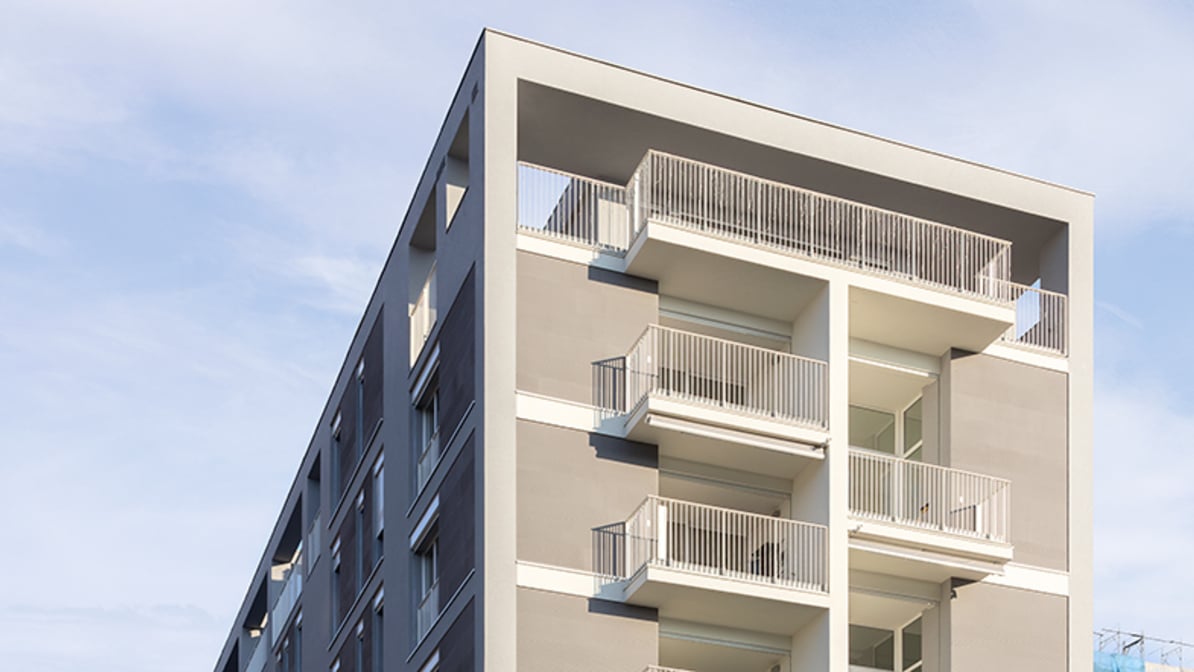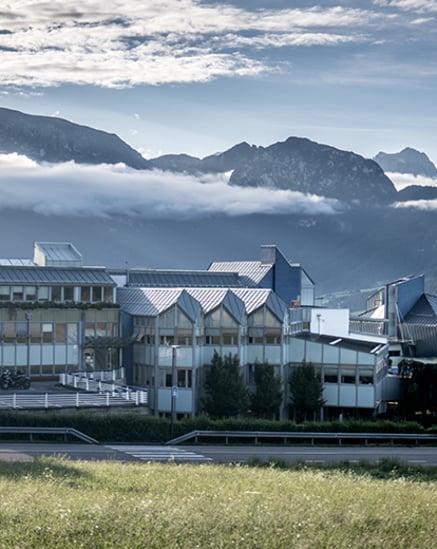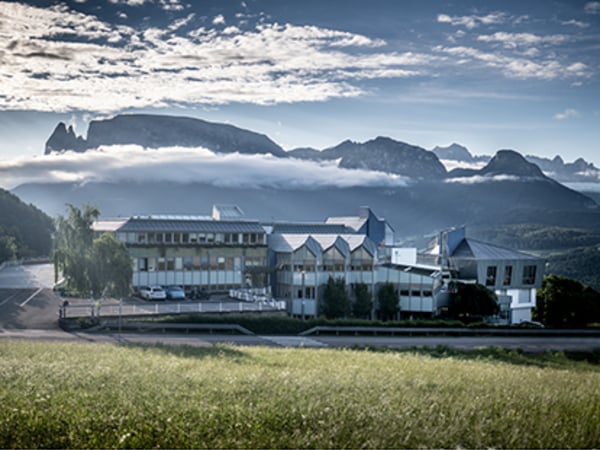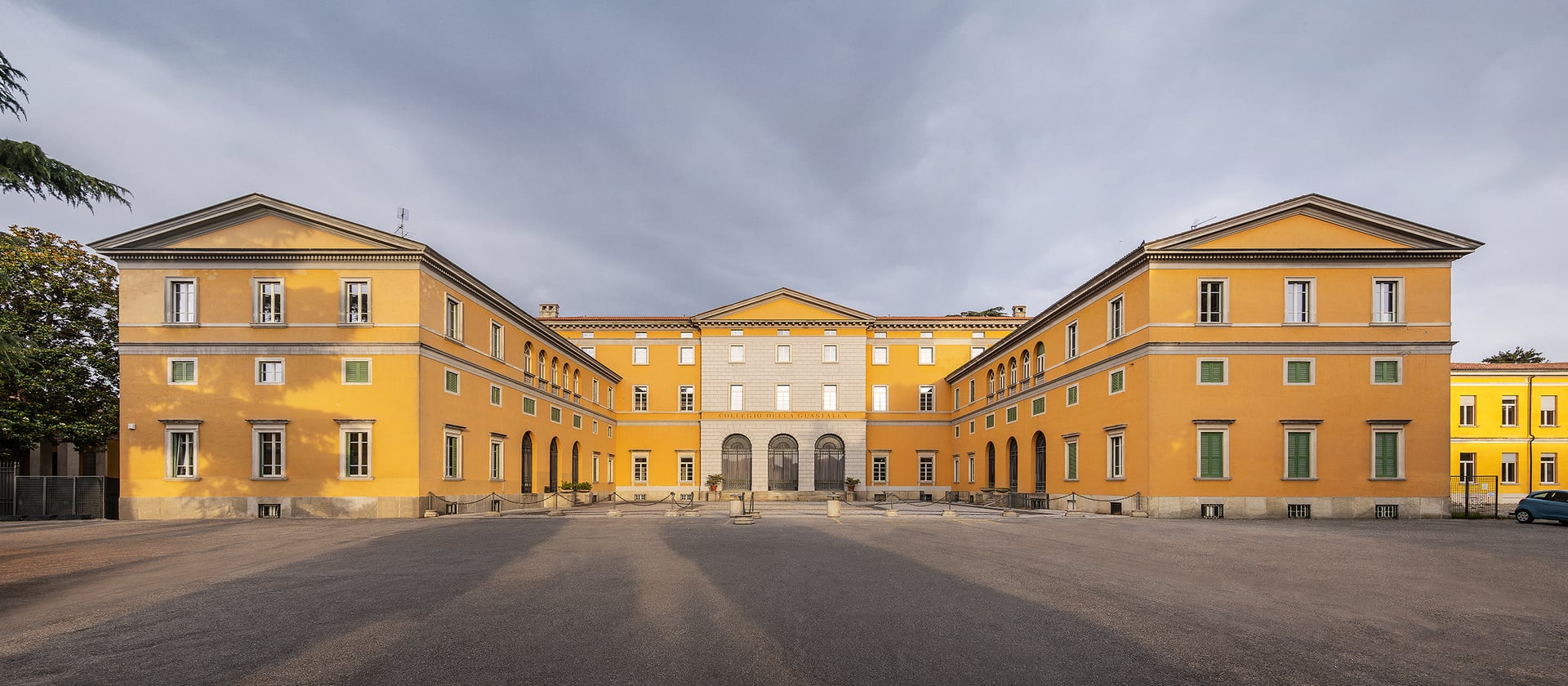
Renovating a historic institution.
The Guastalla College in Monza: windows that act as a bridge between past and present.
Finstral successfully carried out the challenging replacement of windows in a villa dating from the early 19th century that has housed the renowned Guastalla College since 1936. This educational institution accommodates numerous children and young people, from daycare to high school.
It is a cold January morning. Yet while Mother Nature is still hibernating, the Guastalla College is already a hive of activity. Parents bring their little ones to the daycare centre. Children and teenagers trickle into the building, discussing homework done or not quite done – or showing each other the latest highlights on Instagram. Teachers finish their morning conversations with colleagues and make their way to the classrooms. Slowly, everyone finds the right room and the school day begins like any other – with one difference, one that most members of the school family are probably not even aware of: they are in a building that is over 150 years old – but has brand-new windows.
Renovating historic buildings – always a challenge
“Historic buildings always have a fascination as witnesses to another era”, explains Antonio Viscomi, Chairman of the Guastalla Foundation. “But, if you want to preserve this magic, every historic building has at some point to be renovated. For the villa, the time came in 2019 when we realised that we needed new windows. What a challenge!” The historical background is important: the Guastalla College was founded in Milan in 1557 by Paola Ludovica Torelli, Countess of Guastalla, as a boarding school that would provide education and learning for destitute girls. The institution thus boasts a 500-year history. At the instigation of the City of Milan, in 1938 the College was moved from its previous location on Piazza Guastalla to the Villa Barbò Pallavicini in Monza: dating from the first half of the 19th century, this has been a listed building since 1939. “When it became necessary to replace the windows at this unique location, one thing was absolutely clear, both to us and to the Monuments Protection Office”, says Chairman Viscomi: “The building’s original effect, its existing aesthetics, the historic proportions – all of this had to be preserved. The new window elements must under no circumstances appear as extraneous bodies.” He pauses briefly to emphasise the difficulty of the task. “We therefore had to find a window manufacturer who could on the one hand offer us products of the highest quality that would meet all modern requirements, i.e. in terms of thermal insulation, ease of use, operating safety and so on; on the other, the chosen manufacturer had to avoid interfering with the villa’s distinctive style. We were thus looking for windows that would function as a bridge between the past and the present, so to speak.”
“That’s just where we came in”, says Florian Oberrauch of Finstral management, still visibly pleased with the order. “At Finstral, we have long focused on combining innovative functions with individual aesthetics. And our consistently modular system means that we can respond to almost all of our customers’ wishes. For the villa, we recommended windows and window doors with frames made of uPVC that are visually almost indistinguishable from the old, white-painted wooden windows. They are however a considerable improvement in terms of thermal insulation and sealing. “But”, adds Oberrauch, pointing to a picture showing a close-up of the villa’s new windows, “that wasn’t all. Modularity ensures that any of our building components can in principle be combined with any other component. This allowed us to compose the elements that the College required in a targeted manner. Attached glazing bars, brass-coloured handles, a central section with a symmetrical appearance and rounded forms: the historic original impression of the windows was fully preserved, both inside and out – with the window technology at the same time significantly updated.” “But there was more besides”, Viscomi adds: “Finstral was also a good choice in terms of the installation process.”
It is a cold January morning. Yet while Mother Nature is still hibernating, the Guastalla College is already a hive of activity. Parents bring their little ones to the daycare centre. Children and teenagers trickle into the building, discussing homework done or not quite done – or showing each other the latest highlights on Instagram. Teachers finish their morning conversations with colleagues and make their way to the classrooms. Slowly, everyone finds the right room and the school day begins like any other – with one difference, one that most members of the school family are probably not even aware of: they are in a building that is over 150 years old – but has brand-new windows.
Renovating historic buildings – always a challenge
“Historic buildings always have a fascination as witnesses to another era”, explains Antonio Viscomi, Chairman of the Guastalla Foundation. “But, if you want to preserve this magic, every historic building has at some point to be renovated. For the villa, the time came in 2019 when we realised that we needed new windows. What a challenge!” The historical background is important: the Guastalla College was founded in Milan in 1557 by Paola Ludovica Torelli, Countess of Guastalla, as a boarding school that would provide education and learning for destitute girls. The institution thus boasts a 500-year history. At the instigation of the City of Milan, in 1938 the College was moved from its previous location on Piazza Guastalla to the Villa Barbò Pallavicini in Monza: dating from the first half of the 19th century, this has been a listed building since 1939. “When it became necessary to replace the windows at this unique location, one thing was absolutely clear, both to us and to the Monuments Protection Office”, says Chairman Viscomi: “The building’s original effect, its existing aesthetics, the historic proportions – all of this had to be preserved. The new window elements must under no circumstances appear as extraneous bodies.” He pauses briefly to emphasise the difficulty of the task. “We therefore had to find a window manufacturer who could on the one hand offer us products of the highest quality that would meet all modern requirements, i.e. in terms of thermal insulation, ease of use, operating safety and so on; on the other, the chosen manufacturer had to avoid interfering with the villa’s distinctive style. We were thus looking for windows that would function as a bridge between the past and the present, so to speak.”
“That’s just where we came in”, says Florian Oberrauch of Finstral management, still visibly pleased with the order. “At Finstral, we have long focused on combining innovative functions with individual aesthetics. And our consistently modular system means that we can respond to almost all of our customers’ wishes. For the villa, we recommended windows and window doors with frames made of uPVC that are visually almost indistinguishable from the old, white-painted wooden windows. They are however a considerable improvement in terms of thermal insulation and sealing. “But”, adds Oberrauch, pointing to a picture showing a close-up of the villa’s new windows, “that wasn’t all. Modularity ensures that any of our building components can in principle be combined with any other component. This allowed us to compose the elements that the College required in a targeted manner. Attached glazing bars, brass-coloured handles, a central section with a symmetrical appearance and rounded forms: the historic original impression of the windows was fully preserved, both inside and out – with the window technology at the same time significantly updated.” “But there was more besides”, Viscomi adds: “Finstral was also a good choice in terms of the installation process.”
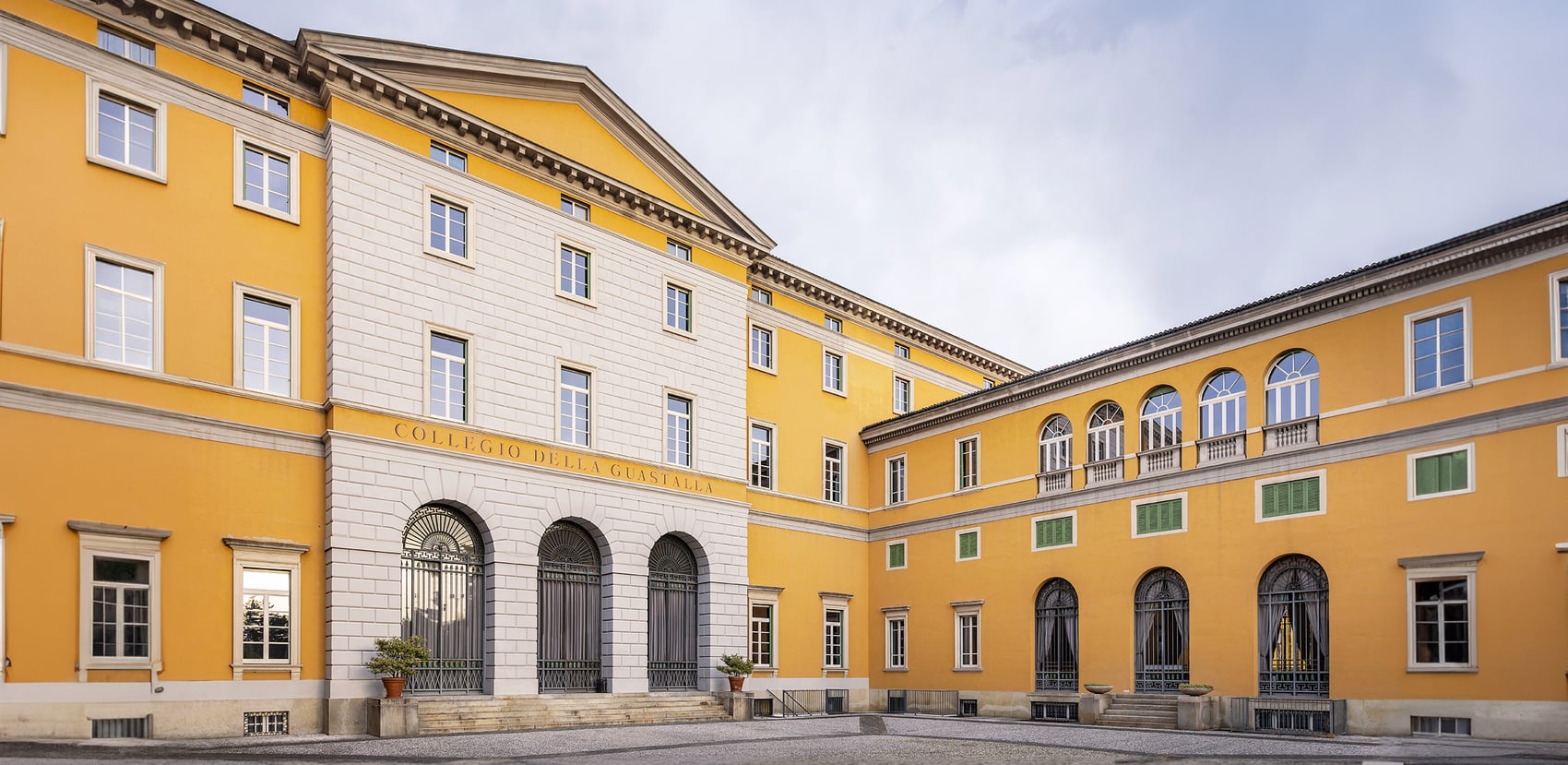
The courtyard of the Guastalla College.
Finstral – top-quality installation skills
“It was clear from the start that the College could not stop classes simply because of the construction site and the building work. It was a major organisational challenge, but it was overcome.” Viscomi was at the time unaware of Finstral’s “slide-on” installation method. Florian Oberrauch explains: “Once we presented the Foundation and the Monuments Protection Office with this special and, so to speak, minimally invasive method using specially prepared samples, everyone involved was quickly convinced”. The best part of slide-on installation is that the old wooden frames do not have to be painstakingly removed from the masonry – they stay in! They are merely cut back, with the new frame and a new joint profile pushed over them and fixed in place. As no masonry work is necessary, slide-on installation means hardly any noise or dirt. And everything is quickly done: a new window can on average be installed in just two hours, thus saving time and money.
Above all, however, this installation method allows complete window replacement to be precisely and reliably planned. “For this project, we not only had to overcome the challenge of dealing with a historic building where a total of 24 new window doors and 349 new window elements had to be installed”, explains Olexandr Pegasin, Finstral project manager for the Contract Service. “This is, after all, a college whose work cannot simply be stopped, outsourced or moved to other times of the day. Many children come in the morning and are picked up again in the afternoon. There is hardly any parking available at these peak times and the access roads get very busy. Notwithstanding the construction work, the safety of all children must be guaranteed during lessons and breaks. Spatial planning therefore had to be coordinated very precisely with the installers: replacement of the windows had to be organised according to which rooms were not being used or could be kept free at that time. Transporting the elements meant that we had to choose unobstructed routes, find alternatives or block off roads. The slide-on installation and excellent organisation allowed us to prepare everything so all went well.”
Finstral – flexible installation methods
And then? “Then came the big surprise”, grins Florian Oberrauch. “We started replacing the windows in September. In the very first week we realised that the condition of some of the old surrounding frames and masonry was too poor for slide-on installation. We therefore had to react quickly and use a different installation method, one that we at Finstral have also mastered, of course, even though it is more complex: installation on the masonry.”
Needless to say, the Finstral installation teams had to alter their plans and employ maximum flexibility: “We could only assess the condition of the surrounding frame after we had removed each window”, explains project manager Pegasin. “We might then have to send for the masons – or perhaps not. Each day was different.” Every week, a kind of timetable was drawn up and coordinated with the school management. In total, six installers, divided into two teams, and three masons worked on the project – for four months. “Yet, despite all the surprises and challenges, we still managed to complete it all according to the original schedule”, smiles Olexandr Pegasin. “And the result was that all of our windows were perfectly installed.”
“It was clear from the start that the College could not stop classes simply because of the construction site and the building work. It was a major organisational challenge, but it was overcome.” Viscomi was at the time unaware of Finstral’s “slide-on” installation method. Florian Oberrauch explains: “Once we presented the Foundation and the Monuments Protection Office with this special and, so to speak, minimally invasive method using specially prepared samples, everyone involved was quickly convinced”. The best part of slide-on installation is that the old wooden frames do not have to be painstakingly removed from the masonry – they stay in! They are merely cut back, with the new frame and a new joint profile pushed over them and fixed in place. As no masonry work is necessary, slide-on installation means hardly any noise or dirt. And everything is quickly done: a new window can on average be installed in just two hours, thus saving time and money.
Above all, however, this installation method allows complete window replacement to be precisely and reliably planned. “For this project, we not only had to overcome the challenge of dealing with a historic building where a total of 24 new window doors and 349 new window elements had to be installed”, explains Olexandr Pegasin, Finstral project manager for the Contract Service. “This is, after all, a college whose work cannot simply be stopped, outsourced or moved to other times of the day. Many children come in the morning and are picked up again in the afternoon. There is hardly any parking available at these peak times and the access roads get very busy. Notwithstanding the construction work, the safety of all children must be guaranteed during lessons and breaks. Spatial planning therefore had to be coordinated very precisely with the installers: replacement of the windows had to be organised according to which rooms were not being used or could be kept free at that time. Transporting the elements meant that we had to choose unobstructed routes, find alternatives or block off roads. The slide-on installation and excellent organisation allowed us to prepare everything so all went well.”
Finstral – flexible installation methods
And then? “Then came the big surprise”, grins Florian Oberrauch. “We started replacing the windows in September. In the very first week we realised that the condition of some of the old surrounding frames and masonry was too poor for slide-on installation. We therefore had to react quickly and use a different installation method, one that we at Finstral have also mastered, of course, even though it is more complex: installation on the masonry.”
Needless to say, the Finstral installation teams had to alter their plans and employ maximum flexibility: “We could only assess the condition of the surrounding frame after we had removed each window”, explains project manager Pegasin. “We might then have to send for the masons – or perhaps not. Each day was different.” Every week, a kind of timetable was drawn up and coordinated with the school management. In total, six installers, divided into two teams, and three masons worked on the project – for four months. “Yet, despite all the surprises and challenges, we still managed to complete it all according to the original schedule”, smiles Olexandr Pegasin. “And the result was that all of our windows were perfectly installed.”
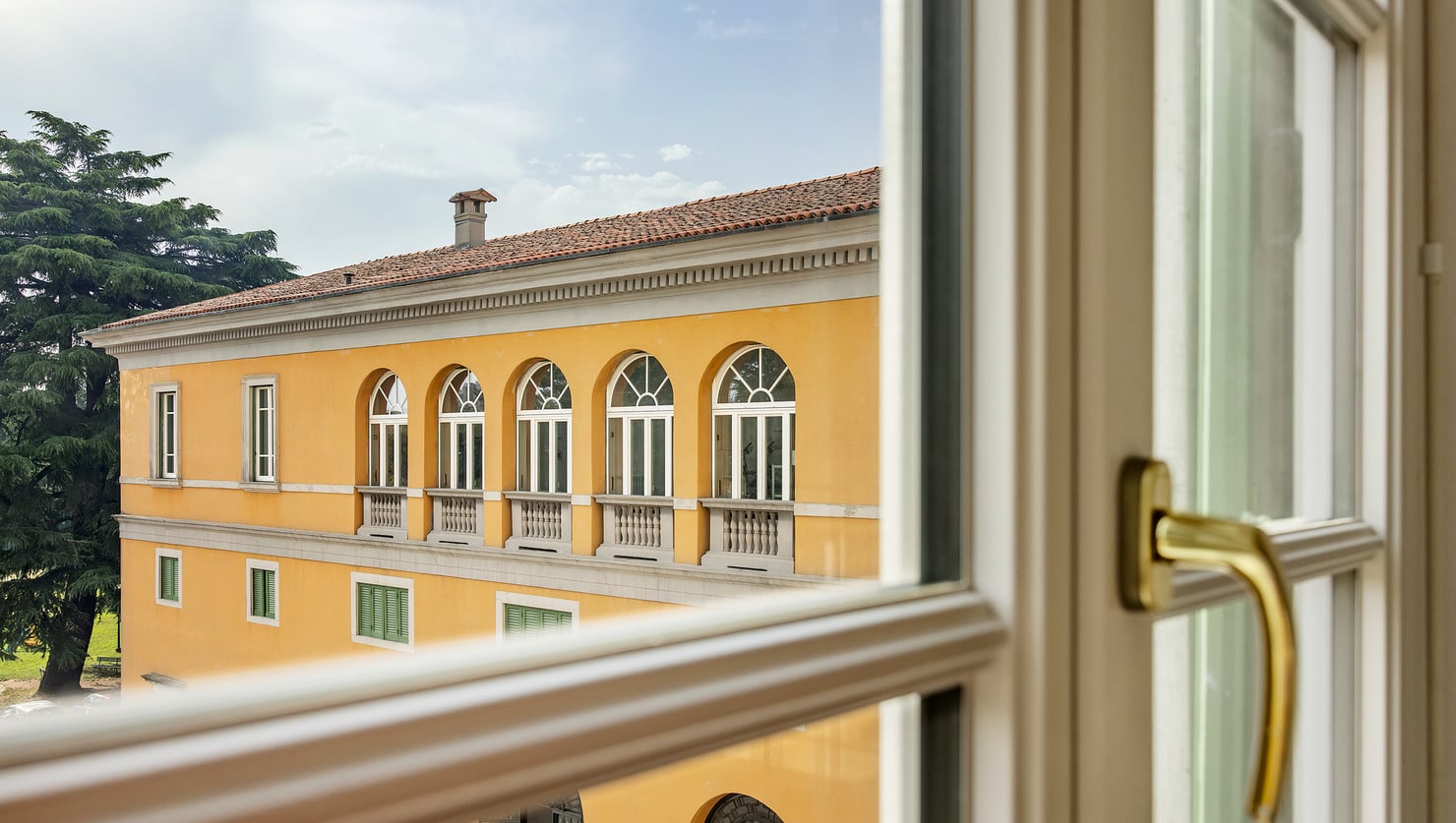
Modern windows offer attractive views.
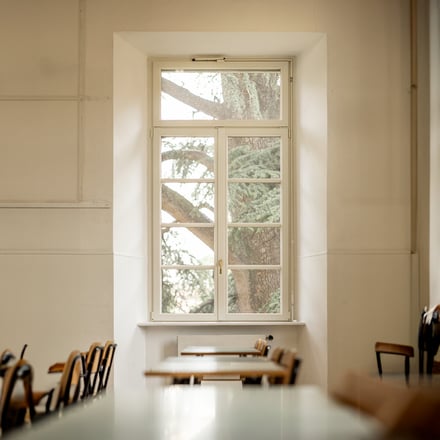
Old-building look in appropriate style with History central section and brass-coloured handle.
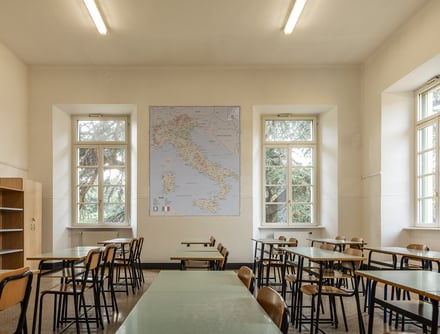
Classroom with new windows.
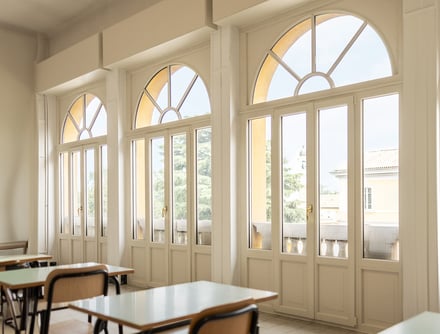
Large round-arch windows with glazing bars and traditional flattened panels preserve the old-building look and ensure plenty of light enters the classrooms.
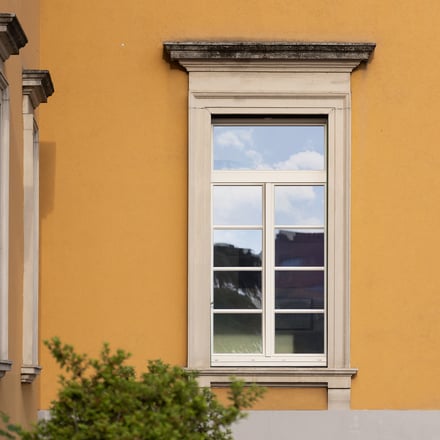
The attached glazing bars give the windows their historical style.
Finstral windows – perfect aesthetics with no functional compromise
“The result is quite simply remarkable”, says a delighted Antonio Viscomi. “The historic aesthetics of the building have not been altered, with the old-style charm preserved, all thanks to Finstral’s products that perfectly matched the project. Visually, the windows are the same – but, in terms of functionality, they cannot be compared to their predecessors.” The uPVC in the core, coextruded centre seals and welded corners all ensure particularly good sealing, while optimal solar protection is provided by the lightweight Mediterran 2 solar control glass in the windows. This prevents the rooms from overheating in summer while simultaneously allowing plenty of daylight to enter the classrooms. For safety there is Multiprotect laminated safety glass, consisting of two panes bonded together with a highly tear-resistant film: if the glass breaks, the film will hold the shards in place, thus minimising the risk of injury. If it is damaged, the pane will shatter, but it cannot be broken – important should a football hit the window.
Taking four months, the project also involved six installers, three masons, 349 windows and 24 window doors. Finstral demonstrated its strengths not only with its consistent modularity, bespoke aesthetics, innovative functionality and smart installation methods: the high degree of flexibility and cooperation demanded by this project also decisively contributed to the successful replacement of the windows. Finstral in this way succeeded in turning windows into bridges – connecting past, present and future.
“The result is quite simply remarkable”, says a delighted Antonio Viscomi. “The historic aesthetics of the building have not been altered, with the old-style charm preserved, all thanks to Finstral’s products that perfectly matched the project. Visually, the windows are the same – but, in terms of functionality, they cannot be compared to their predecessors.” The uPVC in the core, coextruded centre seals and welded corners all ensure particularly good sealing, while optimal solar protection is provided by the lightweight Mediterran 2 solar control glass in the windows. This prevents the rooms from overheating in summer while simultaneously allowing plenty of daylight to enter the classrooms. For safety there is Multiprotect laminated safety glass, consisting of two panes bonded together with a highly tear-resistant film: if the glass breaks, the film will hold the shards in place, thus minimising the risk of injury. If it is damaged, the pane will shatter, but it cannot be broken – important should a football hit the window.
Taking four months, the project also involved six installers, three masons, 349 windows and 24 window doors. Finstral demonstrated its strengths not only with its consistent modularity, bespoke aesthetics, innovative functionality and smart installation methods: the high degree of flexibility and cooperation demanded by this project also decisively contributed to the successful replacement of the windows. Finstral in this way succeeded in turning windows into bridges – connecting past, present and future.
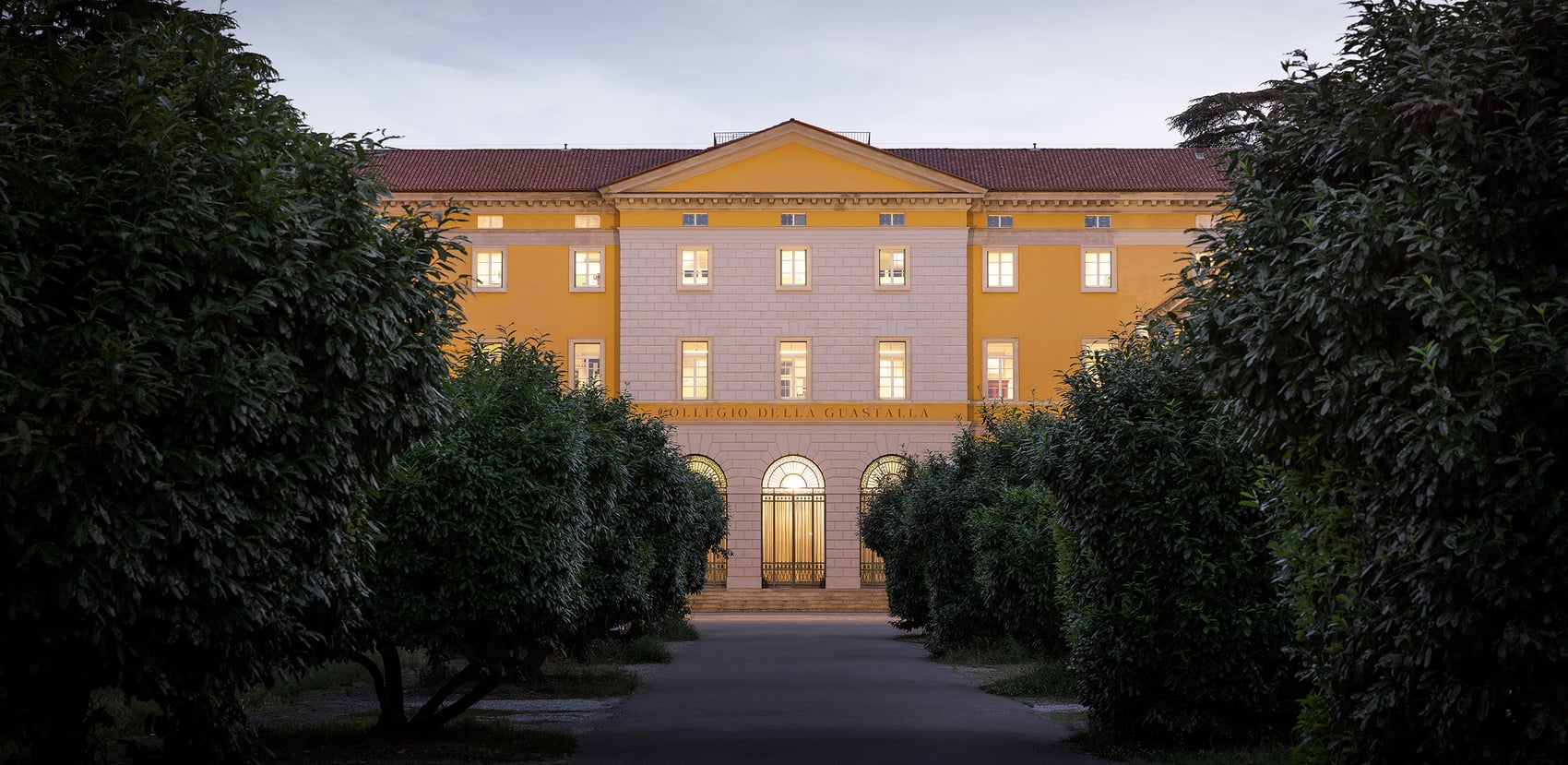
Symmetrical forms and illumination effects at dusk.

The villa also appears magnificent in the evening.

Old-building look with new windows.

The Guastalla College in all its glory.
Still want more?
See here for further interesting reading matter.
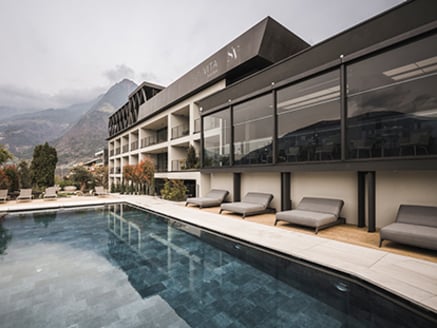

Above Merano on the edge of the village of Dorf Tirol is the Somvis’ family-run hotel, now in the second generation.

